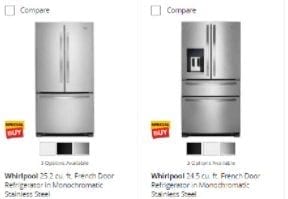There are many types of “conversions” on ecommerce sites. Certainly a purchase is a conversion. But there are also newsletter signups, account creations, social shares, and other actions that indicate visitors’ engagement.
With so much competition for nearly any type of product, online shoppers aren’t always ready to buy. By engaging potential customers, you’re taking steps to build a rewarding relationship.
In this post, I’ll describe 12 types of conversions that are critical for ecommerce companies.
12 Types of Ecommerce Conversions
Email newsletter and text-messaging signups. Having a means to communicate about new products, sales, and special events is key. Use A/B testing to determine when to present this type of offer — e.g., number of pages visited and amount of time on a page or website.

The most popular conversion is the email newsletter signup. Pottery Barn’s prompt is timed to appear later, rather than immediately loading when someone enters the site.
Online account creation. Creating an account is typically reserved for the checkout process. However, some specialty stores have successfully turned it into a shopping requirement. Either way, it offers benefits to the consumer — faster checkout, order history — while providing the business with confirmed demographics.

Because of its niche business model, organic foods retailer Thrive Market requires shoppers to create an account before shopping.
Sharing of content via email or social media. To this day, the best advertising is word-of-mouth. Encouraging visitors to share content should be near the top of every online store’s conversion list.

Pottery Barn takes social sharing even further by gathering user-generated content directly on the product page.
Contest entry. Online contests should be about more than giving things away. They are a great way to build email lists and related databases. Just be sure to include opt-in boxes.
Install an app. Whether your business offers a mobile app or is featured in a third-party app, this call-to-action can help get your brand seen by more people. The best CTA button for these includes the standard OS logos.

Under Armour heavily promotes usage of its apps. Use of the apps keeps the brand in the user’s mind.
Rate a product. Product ratings and reviews are another component of word-of-mouth advertising. They enhance product descriptions. Positive consumer experiences are a double win. They help close more sales and further solidify a legitimate relationship with the reviewer.
View a related product. Most stores list related products at the bottom of the page. Sometimes, though, it makes sense to incorporate them into the product itself. Kohl’s, for example, uses the “Customers Also Viewed” section to help keep visitors from clicking away if the initial product is not exactly what they wanted.

Incorporating related items into the product page works for Kohl’s. Be sure to review analytics to see if works for your product lines.
Request for more information or free materials. A typical conversion tactic used on service sites, this usually centers around providing free digital products in exchange for an email address. It could also be used to generate sales leads for high-dollar products.
Clicking a button to be taken to a specific page or website. Sometimes you just want the visitor to look at something else. This could be a page that provides detailed instructions or videos, or another website that’s focused on a specific product or service. Urban Outfitters prompts visitors to shop customer favorites, which also includes products culled from social media posts. These are usually positioned closer to the bottom of the page, after all other initial selling buttons.

Urban Outfitters is one of the best at curating user generated content.
Answering a survey or providing feedback. I rarely see survey or feedback requests on small business websites, and that confuses me. It is one of the best ways to find out what needs improvement, both on the site itself and in the customer service department. While responders shouldn’t expect to be added to a mailing list automatically, this type of tool puts you in direct communication with those who can provide valuable input.
Voting on content. From wanting to find out what you should sell next, to running user photo or video contests, calling for votes can generate a great deal of action. If you’re running a contest, use a tool that offers additional entries when they share information across social channels.
Making a purchase. I listed this one last because, quite simply, without many of the eleven above, even the best designed “add to cart” button won’t matter much. Shoppers are becoming too savvy to be sold based on website design alone. The ultimate conversion happens after the building of legitimacy, value, and trust.




